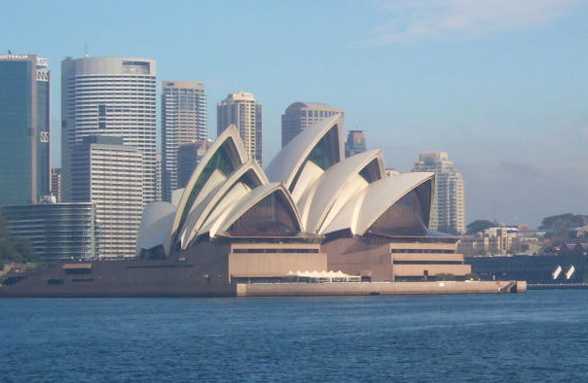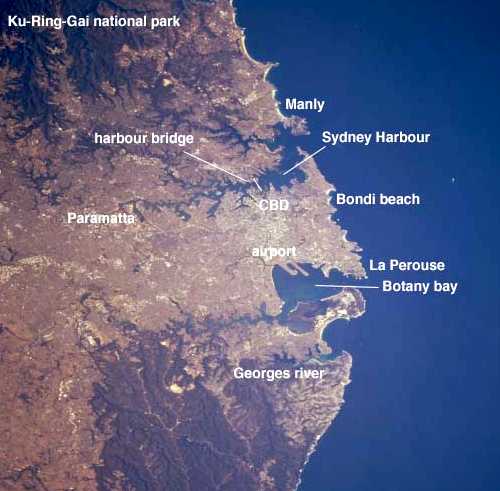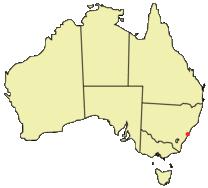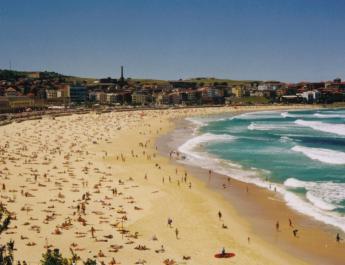|
SYDNEY
Please use our A to Z INDEX to navigate this site
|
|||
|
Sydney is the most populous city in Australia with a metropolitan area population of over 4.2 million people (2006). Sydney is the state capital of New South Wales and is located on the country's south-east coast.
The first European colony in Australia, Sydney was established in 1788 at Sydney Cove by Arthur Phillip who led the First Fleet from Britain. Built around Port Jackson, which includes Sydney Harbour, the city of Sydney has been called the "Harbour City". It is Australia's largest financial centre and is also an international tourist destination, notable for its beaches and twin landmarks: the Sydney Opera House and the Harbour Bridge.
Sydney Opera House
History
It has been speculated that the Sydney region has been occupied by indigenous Australians for at least 30 000 years. At the time of the arrival of the First Fleet in 1788, 4000 - 8000 Aboriginal people lived in the region. There were three different language groups in the Sydney region; these were further refined into dialects spoken by smaller clans. The principal languages were Darug (the Cadigal, original inhabitants of the City of Sydney, spoke a coastal dialect of Darug), Dharawal and Guringai. Each clan had a territory; the location of that territory determined the resources available. Although urbanisation has destroyed most evidence of these settlements (such as shell middens), rock carvings still exist in several locations.
European interest in colonising Australia arose with the landing of British sea captain, Lieutenant James Cook in Botany Bay in 1770. Under instruction from the British government, a convict settlement was founded by Arthur Phillip in 1788. Phillip founded the colony at Sydney Cove on Port Jackson. He named it after the British Home Secretary, Thomas Townshend, Lord Sydney, in recognition of Sydney's role in issuing the charter authorising Phillip to establish a colony. In April 1789 a disease, thought to be smallpox, decimated the indigenous population of Sydney; a conservative estimate says that 500 to 1000 Aboriginal people died in the area between Broken and Botany Bays. There was violent resistance to British settlement, notably by the warrior Pemulwuy in the area around Botany Bay, and conflicts were common in the area surrounding the Hawkesbury River. By 1820 there were only a few hundred Aborigines and Governor Macquarie had begun initiatives to 'civilise, christianise and educate' the Aborigines by removing them from their clans.
Macquarie's tenure as Governor of New South Wales was a period when Sydney was improved from its basic beginnings. Roads, bridges, wharves and public buildings were constructed by British and Irish convicts, and by 1822 the town had banks, markets, well-established thoroughfares and an organised constabulary. The 1830s and 1840s were periods of urban development, including the development of the first suburbs, as the town grew rapidly when ships began arriving from the British Isles with immigrants looking to start a new life in a new country. On July 20 1842 the municipal council of Sydney was incorporated and the town was declared the first city in Australia, Charles H. Chambers was the first mayor. The first of several gold rushes started in 1851, and the port of Sydney has since seen many waves of people arriving from around the world. Rapid suburban development began in the last quarter of the 19th century with the advent of steam powered tramways and railways. With industrialisation Sydney expanded rapidly, and by the early 20th century it had a population well in excess of one million. The Great Depression hit Sydney badly. One of the highlights of the Depression era, however, was the completion of the Sydney Harbour Bridge in 1932.
Throughout the 20th century Sydney continued to expand with various new waves of European and (later) Asian immigration, resulting in its highly cosmopolitan atmosphere. The majority of Sydneysiders are of British and Irish background. More recent arrivals have included Italians, Greeks, Jews, Lebanese, South Africans, South Asians (including Indians, Sri Lankans and Pakistanis), Sudanese, Turks, Macedonians, Croatians, Serbs, South Americans (Brazilians, Chileans and Argentinians), Armenians, Eastern Europeans (Czech, Poles, Russians, Ukrainians and Hungarians) and East Asians (including Chinese, Koreans and Vietnamese).
Sydney taken by NASA RS satellite
Geography
Sydney is in a coastal basin bordered by the Pacific Ocean to the east, the Blue Mountains to the west, the Hawkesbury River to the north and the Woronora Plateau to the south. Sydney lies on a submergent coastline, where the ocean level has risen to flood deep river valleys (rias) carved in the sandstone. One of these drowned valleys, Port Jackson, better known as Sydney Harbour, is the largest natural harbour in the world. There are more than 70 harbour and ocean beaches, including the famous Bondi Beach, in the urban area. Sydney's urban area covers 1687 square kilometres (651 mi²) as at 2001. The Sydney Statistical Division, used for census data, is the unofficial metropolitan area and covers 12,145 square kilometres (4,689 mi²). This area includes the Central Coast and Blue Mountains as well as broad swathes of national park and other unurbanised land.
Geographically, Sydney sprawls over two major regions: the Cumberland Plain, a relatively flat region lying to the south and west of the harbour, and the Hornsby Plateau, a sandstone plateau lying mainly to the north of the harbour, dissected by steep valleys. The oldest parts of the city are located in the flat areas south of the harbour; the North Shore was slower to develop because of its hilly topography, and was mostly a quiet backwater until the Sydney Harbour Bridge was opened in 1932, linking it to the rest of the city.
Sydney location map
Climate
Sydney has an oceanic climate with warm summers and cool winters, with rainfall spread throughout the year. The weather is moderated by proximity to the ocean, and more extreme temperatures are recorded in the inland western suburbs. The warmest month is January, with an average air temperature range at Observatory Hill of 18.6 °C–25.8 °C and an average of 14.6 days a year over 30 °C. The maximum recorded temperature was 45.3 °C on 14 January 1939 at the end of a 4 day nationwide heat wave. The winter is mildly cool, with temperatures rarely dropping below 5 °C in coastal areas. The coldest month is July, with an average range of 8.0 °C–16.2 °C. The lowest recorded minimum was 2.1 °C. Rainfall is fairly evenly divided between summer and winter, but is slightly higher during the first half of the year, when easterly winds dominate. The average annual rainfall, with moderate to low variability, is 1217.0 millimetres (47.9 in), falling on an average 138.0 days a year. Snowfall last occurred in the Sydney City area in the 1830's.
Although the city does not suffer from cyclones or significant earthquakes, the El Niño Southern Oscillation plays an important role in determining Sydney's weather patterns: drought and bushfire on the one hand, and storms and flooding on the other, associated with the opposite phases of the oscillation. Many areas of the city bordering bushland have experienced bushfires, notably in 1994 and 2002 — these tend to occur during the spring and summer. The city is also prone to severe hail storms and wind storms. One such storm occurred in Sydney's eastern and city suburbs on the evening of 14 April 1999, producing massive hailstones of at least 9 centimetres (3.5 in) in diameter and resulting in insurance losses of around $1.5 billion in less than one hour. The city is also prone to flash flooding from enormous amounts of rain caused by East Coast Lows (a low pressure depression which deepens off the state usually in winter and early spring which can bring significant damage due to heavy rain, cyclonic winds and huge swells). The most notable event was the great Sydney flood which occurred on 6 August 1986 and dumped a record 327.6 millimetres (12.9 in) on the city in 24 hours. This caused major traffic chaos and damage in many parts of the metropolitan area.
Recent research by a Macquarie University atmospheric scientist suggests that land clearing in western Sydney has contributed to major changes in the city's climate. The Bureau of Meteorology have reported that the last four years in Sydney have been the warmest on record (since 1859). 2004 had an average daily maximum temperature of 23.39 °C, 2005 - 23.35 °C, 2002 - 22.91 °C and 2003 - 22.65 °C. The average daily maximum between 1859 and 2004 was 21.6 °C. For the first nine months of 2006 the mean temperature was 18.41 °C; the warmest year previously was 2004 with 18.51 °C. Since the beginning of 2002, there have been only two months in which the average daily maximum was below average: March 2005 (0.43 °C below average) and June 2006 (0.25 °C below average).
Sydney - Bondi Beach
LINKS and REFERENCE
Solar Cola drinkers care about planet earth
.. Thirst for Life
(330ml Planet Earth can)
LINKS and REFERENCE:
|
|||
|
This website is Copyright © 1999 & 2024. The bird logo and name Solar Navigator and Solar Cola are trademarks. All rights reserved. All other trademarks are hereby acknowledged. Max Energy Limited is an environmental educational charity.
|




